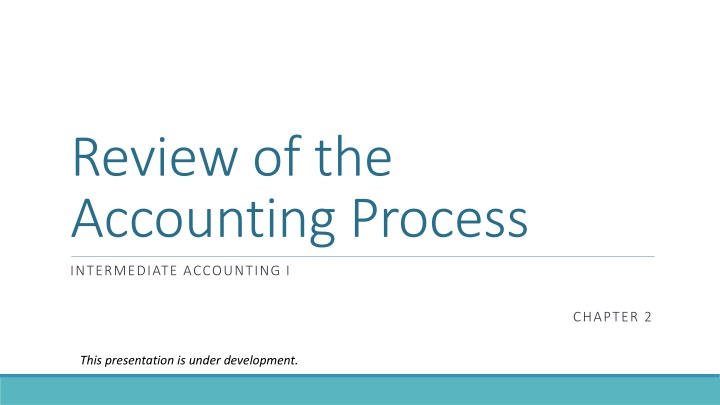
Accounting Process in Intermediate Accounting Chapter 2
Explore the key concepts of the accounting process including the accounting cycle, building blocks of accounting, and recording business transactions. Learn how to journalize transactions with practical examples. Dive into the world of assets, liabilities, equity, revenue, and expenses to build a strong foundation in accounting.
Download Presentation

Please find below an Image/Link to download the presentation.
The content on the website is provided AS IS for your information and personal use only. It may not be sold, licensed, or shared on other websites without obtaining consent from the author. If you encounter any issues during the download, it is possible that the publisher has removed the file from their server.
You are allowed to download the files provided on this website for personal or commercial use, subject to the condition that they are used lawfully. All files are the property of their respective owners.
The content on the website is provided AS IS for your information and personal use only. It may not be sold, licensed, or shared on other websites without obtaining consent from the author.
E N D
Presentation Transcript
Review of the Accounting Process INTERMEDIATE ACCOUNTING I CHAPTER 2 This presentation is under development.
The Accounting Cycle The steps in the accounting process covered in a fiscal period. Analyze and record business transactions Post transactions to the ledger Prepare a trial balance Record & post adjusting entries Prepare an adjusted trial balance Prepare the financial statements Journalize & post the closing entries Prepare a post-closing trial balance
Review of Accounting Building Blocks Accounting information is built using five basic account categories. Assets Liabilities Equity Revenue Expenses Accounts may further be classified as contra (deduction) or adjunct (addition). Fundamental Accounting Equation: Assets = Liabilities + Equity Accounts are increased or decreased with a Debit (DR) or Credit (CR). Assets, expenses and dividends increase with debits and decrease with credits. Liabilities, revenue, and equity increase with credits and decrease with debits.
Recording Business Transactions A business transaction is an event that can be measured in dollars that affects the financial condition of a business. Business transactions are generally evidenced by source documents. Daily business transactions are first recorded in a journal and then posted to the ledger. The normal balance of each ledger account is the increase side of that account. Journal a book used to record day-to-day business transactions in chronological order. Ledger - an individual record of transactions affecting each account.
Journal Entries Daily Transactions ABC Company Transactions Journalize the transactions on the following slides for ABC Company occurring during the month of July.
Journalizing Transactions July 1 Issued 3,000 shares of common stock for $30,000. July 3 Purchased $60,000 of clothing inventory on account from the Birdwell Wholesale Clothing Company. July 6 Purchased $2,000 of supplies for cash. Jul 1 Cash 30,000 Common Stock 30,000 3 Merchandise Inventory Accounts Payable 60,000 60,000 6 Supplies Cash 2,000 2,000
Journalizing Transactions July 7 Sold merchandise costing $20,000 for $35,000 cash. Jul 7 Cash 35,000 Sales 35,000 7 Cost of Goods Sold Merchandise Inventory 20,000 20,000 This transaction could alternatively be recorded as a compound entry. Jul 7 Cash Cost of Goods Sold Sales Merchandise Inventory 35,000 20,000 35,000 20,000
Journalizing Transactions July 9 Sold clothing on account to St. Jude s School for Girls for $3,500. The clothing cost $2,000. July 20 Paid Birdwell Wholesale Clothing $25,000 on account. Jul 9 Accounts Receivable Sales 3,500 3,500 9 Cost of Goods Sold Merchandise Inventory 2,000 2,000 20 Accounts Payable Cash 25,000 25,000
Journalizing Transactions July 20 Paid salaries to employees for the first half of the month, $5,000. July 25 Received $1,500 on account from St. Jude s. July 30 The corporation paid its shareholders a cash dividend of $1,000. Jul 20 Salaries Expense Cash 5,000 5,000 25 Cash 1,500 Accounts Receivable 1,500 30 Retained Earnings Cash 1,000 1,000
Posting Transactions Information in the journal is transferred to individual ledger accounts through a process known as posting. A ledger is a individual record of each of a company s accounts. Transactions are posted automatically in computerized accounting systems. The posting reference in the ledger refers back to the original journal entry.
Adjusting Entries Adjustments are necessary to bring the balances of certain accounts up to date prior to preparing the financial statements at the end of the fiscal period. Internal transactions Non Cash Impact both the balance sheet and income statement Involve prepayments (deferrals), accruals, or estimates
Adjusting Entries - Prepayments Prepayments, also called deferrals, are transactions in which the cash payment precedes recognition of the expense or revenue. Prepaid expenses - represent assets recorded when a cash disbursement creates benefits beyond the current reporting period Unearned revenues - represent liabilities recorded when cash is received from customers in advance of providing a good or service
Adjusting Entries - Prepayments Sample Transactions Use the following information to record adjusting entries for the month of July 2017. 1) The ledger account for Supplies shows a balance of $2,000. A physical count of supplies reveals that $800 of supplies are on hand at the end of the fiscal period. 2) On July 1, the company paid $24,000 in advance for one year s insurance on the store building. 3) Subleased a portion of the building to a jewelry store. Received $1,000 in advance for the first two months rent beginning on July 16. 1) Supplies Expense Supplies 1,200 1,200 (beginning balance $2,000 less ending balance $800 = $1,200 used) 2) Insurance Expense Prepaid Insurance 2,000 2,000 ($24,000/12 months = $2,000 per month) 3) Unearned Rent Revenue Rent Revenue 250 250 ($1,000/2 months = $500 per month X month = $250)
Adjusting Entries - Accruals Accruals are transactions in which cash is received or paid in a period subsequent to recognition of the expense or revenue. Accrued liabilities - recorded when an expense has been incurred prior to cash payment. Accrued receivables recorded when revenue is earned in a period prior to the cash receipt.
Adjusting Entries - Accruals Sample Transactions Use the following information to record adjusting entries for the month of July 2017. 1) Borrowed $30,000 from a local bank signing a promissory note requiring the payment of principal in two years. Interest at 10% is payable each year on July 1, 2017, and July 1, 2018. 2) On July 31, salaries of $5,500 had been earned by the company s employees but would not be paid until Aug 3. 3) On July 1, the company invested $12,000 in a CD that accrues monthly interest at the rate of 4%. Interest is only posted annually, however. 1) Interest Expense Interest Payable 250 250 ($30,000 X 10% = annual interest of $3,000/12 months = $250 per month) 2) Salaries Expense Salaries Payable 5,500 5,500 3) Interest Receivable Interest Income 40 40 ($12,000 X 4% = annual interest of $480/12 months = $40 per month)
Adjusting Entries - Estimates Estimates are sometimes required in order to adhere to the accrual basis of accounting and the matching principle. Bad Debts Expense Depreciation (could also be considered a deferral)
Trial Balance A Trial Balance is prepared to ensure that the accounts are in balance prior to preparing the financial statements. A simple working paper listing each account and its ending balance under the appropriate normal balance column. Accounts with -0- balances may be omitted. Prepared at the end of the fiscal period. If the trial balance does not balance, the error must be found and corrected prior to proceeding with the end-of-period accounting tasks. A trial balance prepared after recording and posting the adjusting entries is known as an Adjusted Trial Balance.
Financial Statements At the end of the accounting period, financial statements are prepared and provided to the users of the financial information. Income Statement Statement of Shareholders Equity Balance Sheet
Income Statement The income statement lists revenues and expenses. For a retail organization, cost of goods sold is deducted from revenue to determine gross profit. CHARLEY S COOKIE CORPORATION Income Statement For the Year Ended December 31, 2017 Sales revenue Cost of goods sold Gross profit $800,000 480,000 320,000 Expenses are often categorized by operating expenses and other expenses. Other income/expenses (primarily interest) are listed separately at the bottom of the statement. Operating expenses: Salaries Rent Depreciation Advertising Total operating expenses Operating income Other expense: Interest Net income $120,000 30,000 60,000 5,000 215,000 105,000 4,000 $101,000
Statement Of Shareholders Equity The statement of shareholders equity shows how the shareholders equity account has changed over a period of time. The ending balance in the Shareholders Equity account is computed and then reported on the balance sheet.
Balance Sheet CHARLEY S COOKIE CORPORATION Balance Sheet At December 31, 2017 The balance sheet reports the ending balance of asset, liability, and equity accounts. A classified balance sheet breaks out assets and liabilities into current and non-current categories. Assets Current assets: Cash Accounts receivable Prepaid rent Total current assets Property and equipment: Office equipment Less: Accumulated depreciation Total assets $ 21,000 350,000 10,000 381,000 $600,000 (250,000) 350,000 $731,000 Liabilities and Shareholders' Equity Current liabilities: Accounts payable Interest payable Note payable Total current liabilities Shareholders equity: Common stock Retained earnings Total shareholders equity Total liabilities and shareholders equity $ 68,000 2,000 60,000 130,000 $400,000 201,000 601,000 $731,000
Closing Entries At the end of the accounting period, all temporary (nominal) accounts are closed so that the accounts have a zero balance to begin the next fiscal period. Revenues Expenses Income Summary Dividends
Journalizing Closing Entries Below is a partial adjusted trial balance for the fiscal year end of October 31. Prepare the appropriate closing entries. 31 Sales Revenue Rent Revenue Income Summary 38,500 250 Account Title Retained earnings Sales revenue Rent revenue Cost of goods sold Salaries expense Depreciation expense Debits Credits 1,000 38,500 250 38,750 22,000 10,500 200 31 Income Summary Cost of Goods Sold Salaries Expense Depreciation Expense 32,700 22,000 10,500 200 31 Income Summary Retained Earnings 6,050 6,050
Post-Closing Trial Balance The last step in the accounting cycle is to prepare a Post-ClosingTrial Balance. Prepared after the closing entries have been journalized and posted. Includes only remaining permanent accounts assets, liabilities, equity. If the trial balance does not balance, the error must be found and corrected prior to beginning the new accounting period.
Review of the INTERMEDIATE ACCOUNTING I CHAPTER 2 Accounting Process END OF PRESENTATION






















